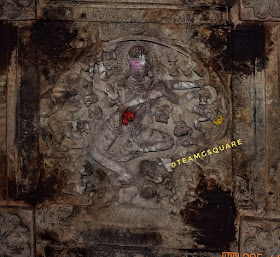The Fort at Ramadevara Betta is a large one with 7 tiers. Much of the fortification still remains intact and one can get a clear picture of the mighty fort that once stood here. The lower fortification extended up till the river Arkavathi and had enclosed the erstwhile town of Ramagiri. However today, the town has disappeared, with a few mango groves and farms taking its place. The lower fortification on the river bank is still intact at a few places. Except for the fortification and temples around, most of the other structures are lost. There are at least 5 water ponds present at various levels of fortification, apart from the river which has served as a source of drinking water.
 |
Old Steps With Fortification
|
From the entrance to the fort, a tier of fortification with old steps is visible to us. Currently, there are well laid steps leading us to the temple dedicated to Lord Pattabhirama. There are two routes from the temple site, one towards the lower fortification which takes us through 3 tiers of fortification up till the river and the second takes us to the upper fortification. First time during our visit, we chose the route towards the river. At the 5th gateway near the temple is a beautiful carving of Lord Krishna accompanied by Lords Garuda and Anjaneya. Going further down the steps, we reached the spot of Kote Anjaneya Swamy which is believed to have been installed 700 years ago located close to the 4th gateway. While we offered our prayers to the lord here, we came to know from the priest about the presence of a carving of Lord Rama's feet further down for which we had to cross two more gateways to reach.
 |
Locally Known as 'Ramana Gundu'
|
 |
Bird's Eye View From Top of Rama Devara Betta
|
On one of the rocks on our way down is a carving of Lord Ganesha and a little further lies a water pond. After exploring around, we walked further down to reach the spot of the carving of Lord Rama's Feet. We met an elderly person who upon inquiry went on to explain the story about Sri Kempegowda taking refuge near the place of the carving and also getting a dream of building a fort here. He also narrated that Sri Kempegowda found some treasure here from which he was able to build Bengaluru. There is a small temple built recently that houses a carving of Lord Anjaneya along with other sculptures. We were also informed that a walk of about 10 mins from will lead us to the first tier of fortification near the river. As we had other plans, we could not explore that side of the fortification and it was also too late to trek towards the upper fortification.
 |
5th Gateway of Ramagiridurgam
|
 |
Lord Ganesha Carved On a Rock
|
During our next visit, we explored the upper fortification wherein the 6th and 7th gateways remain completely destroyed. The route towards the top is easy to climb except for the last stretch. This last stretch is known as the Honna Kumbhi Betta. A a security guard appointed by the forest department always remains stationed at this point to control the crowd movement. This place is so named since it is believed that Sri Kempegowda found a treasure here, thus the name honna (gold) and the shape of the hill when seen from the Bengaluru side is conical and thus the name kumbhi. Right at the start of this stretch is the famed carving of the Vanara King Sugriva. A set of rock cut steep steps lead us to the top. The top most part of the fort is a big plateau region with one big water pond and ruins of fortification spread here and there. The views from the top is simply astounding and mesmerizing. We spent some time here after which we got down to have the darshan of Lord Pattabhirama. Anna prasadam was also served at the temple (served on weekends and special days).
 |
Climb Up to Honna Kumbi Betta
|
 |
Water Pond
|
The Fort is believed to have been built/strengthened by the Nadaprabhu Kempegowda's Family. Later, it was captured by the Mysore Wodeyars, after which it came under the control of Hyder Ali and finally was captured in 1791 by the British under the captaincy of Welch. The people who lived here slowly moved out and settled in Closepet (erstwhile name of Ramanagara). Buchchanan says that "The place is dreadfully infested by tigers, especially the fort, which occupies a large rocky hill, capable of a very tedious defense, even without any assistance from art". During Buchanan's visit here, this place was inhabited by the Eriligaru/ Iruligas (a local hill tribe).
 |
Ramadevara Betta Viewed From Arkavathi River Bank
|










































